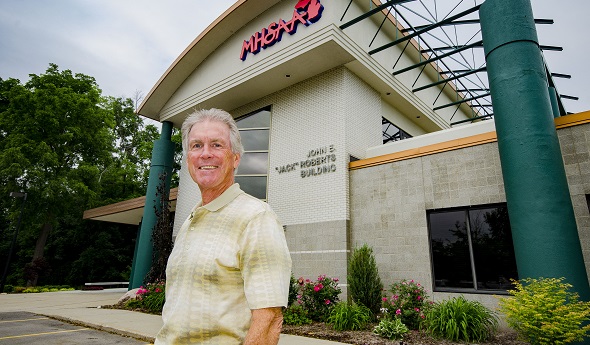
MHSAA Building Named for Retiring Director
By
Geoff Kimmerly
MHSAA.com senior editor
June 26, 2018
To recognize 32 years of leadership and service to Michigan educational athletics, the MHSAA Representative Council has named its home office in East Lansing after longtime Executive Director John E. “Jack” Roberts, who will retire in August.
The dedication of the “John E. ‘Jack’ Roberts Building” was approved by the Council during its Spring Meeting, May 6-7 in Gaylord, with the fabrication and assembly of the lettering financed by several private donations.
The building, located at 1661 Ramblewood Drive in East Lansing, opened as headquarters for the Association on January 3, 1997. The 20,000-square-foot, two-story facility houses MHSAA staff offices and resources including a publications library, plus multiple conference spaces frequently used to host meetings not only for MHSAA business but by leagues, coaches associations and other groups joining people from across the state.
Roberts, who announced his retirement April 24, will conclude his tenure next month as the second-longest serving full-time executive director during the MHSAA’s 94-year history. He is the fourth person to serve that leadership role full time, following Charles E. Forsythe (1931-42, 1945-68), Allen W. Bush (1968-78) and Vern L. Norris (1978-86). Roberts currently is also the nation’s longest-serving executive director of a state high school athletic association.
“This is an entirely unexpected honor,” Roberts said, “and while I am proud of the building, I’m even prouder of the people who have worked in it.”
The metallic lettering announcing the building’s name was designed by Image360 of Brighton and placed on the façade at the center of the building below the large MHSAA logo facing the property’s parking lot.
John Peckham, then of Martin Property Development of East Lansing, oversaw the original Ramblewood project. The building was designed by Keystone Design and built by Granger Construction.
Prior to the move to its current offices, the MHSAA was housed at 1019 Trowbridge Road in East Lansing from 1976-96. The MHSAA moved to the Trowbridge location from a downtown Lansing office it had leased since 1958.
With his retirement upcoming, Roberts also will leave the National Federation of State High School Associations (NFHS) Board of Directors later this week during the Summer Meeting in Chicago. He also will conclude an extended term as board chairperson of the NFHS Network. Roberts previously served as an assistant director for the National Federation from 1973-80 and came to the MHSAA in the fall of 1986 from the Fellowship of Christian Athletes, which he served as executive vice president.
Assistant Director Mark Uyl was chosen by the Representative Council in May to succeed Roberts as MHSAA executive director.
The MHSAA is a private, not-for-profit corporation of voluntary membership by more than 1,500 public and private senior high schools and junior high/middle schools which exists to develop common rules for athletic eligibility and competition. No government funds or tax dollars support the MHSAA, which was the first such association nationally to not accept membership dues or tournament entry fees from schools. Member schools which enforce these rules are permitted to participate in MHSAA tournaments, which attract more than 1.4 million spectators each year.

Eight Members Elected to MHSAA Representative Council
By
Geoff Kimmerly
MHSAA.com senior editor
September 26, 2024
Elections were completed recently to fill positions on the Michigan High School Athletic Association’s legislative body, its Representative Council, with seven members receiving re-election from their respective constituencies and one new member selected to join the Council beginning with its Fall meeting this December.
Four of the seven re-elected members ran unopposed. Midland athletic director Eric Albright was re-elected to continue representing Class A and B schools in the northern section of the Lower Peninsula, and Portage Northern athletic director Chris Riker was re-elected to continue representing Class A and B schools in the southwestern section of the Lower Peninsula. Bangor athletic director Fredrick J. Smith was re-elected to represent junior high and middle schools, and Vic Michaels, director of physical education and athletics for the Archdiocese of Detroit, was re-elected to continue representing private and parochial schools.
Winning re-election by majority votes were Harbor Springs athletic director Anna Rigby to continue representing Class C and D schools in the northern section of the Lower Peninsula, Brighton athletic director John Thompson to continue representing Class A and B schools in the southeastern section of the Lower Peninsula, and Calumet faculty member and past athletic director Sean Jacques to continue representing Class C and D schools in the Upper Peninsula.
Fenton High School principal Michael Bakker was elected for the first time, for a statewide at-large position. He ran unopposed.
All eight were elected to serve two-year terms.
The Representative Council is the 19-member legislative body of the MHSAA. All but five members are elected by member schools. Four members are appointed by the Council to facilitate representation of females and minorities, and the 19th position is occupied by the Superintendent of Public Instruction or designee. The Council meets three times annually. Five members of the Council convene monthly during the school year to form the MHSAA’s Executive Committee, which reviews appeals of Handbook regulations by member schools.
Additional elections took place to select representatives to the Upper Peninsula Athletic Committee. Lake Linden-Hubbell athletic director and varsity girls basketball coach Jack Kumpula was re-elected to represent Class D schools. West Iron County High School and Middle School principal, athletic director and varsity football coach Mike Berutti was re-elected to represent high school athletic coaches.
The MHSAA is a private, not-for-profit corporation of voluntary membership by more than 1,500 public and private senior high schools and junior high/middle schools which exists to develop common rules for athletic eligibility and competition. No government funds or tax dollars support the MHSAA, which was the first such association nationally to not accept membership dues or tournament entry fees from schools. Member schools which enforce these rules are permitted to participate in MHSAA tournaments, which attract more than 1.4 million spectators each year.

